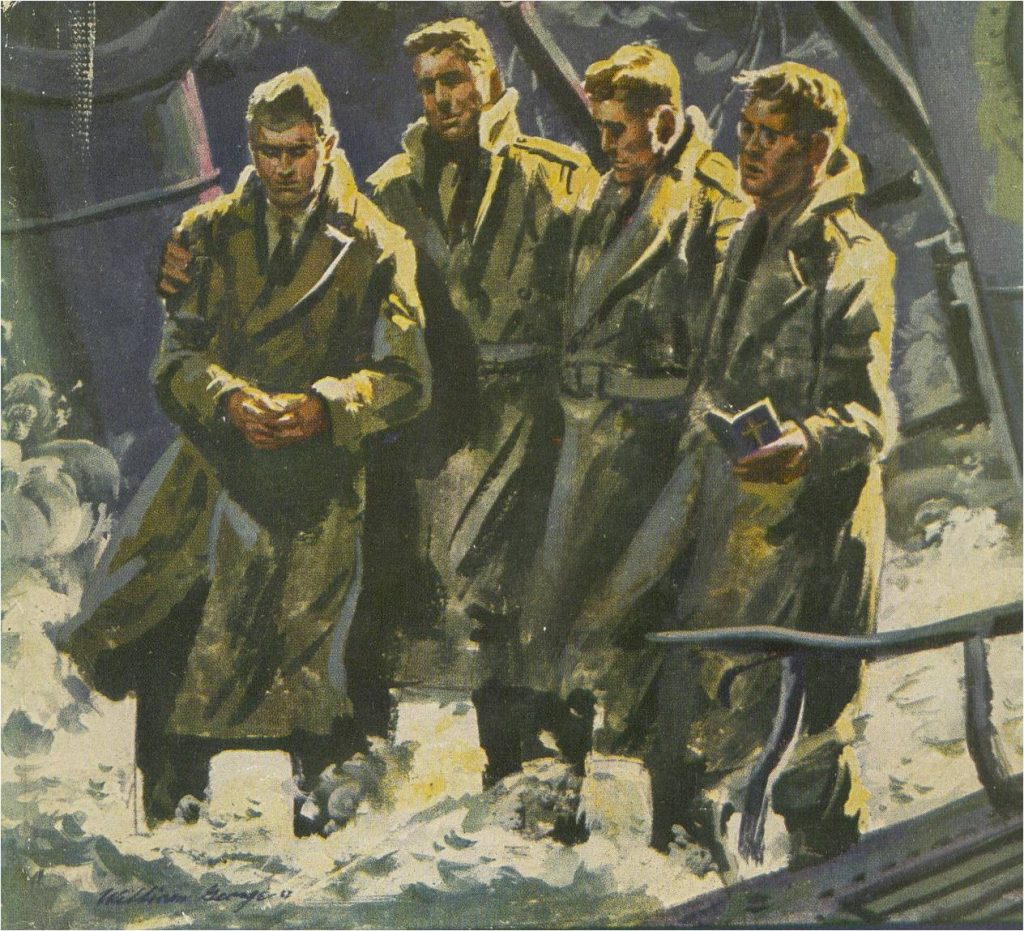
Four Chaplains, One Heroic Mission
“Chaplains risk and give their lives along with the troops,” Daniel Poling, pastor of Grace Baptist in Philadelphia, told his son. Daniel knew full well, having served as Chaplin during WWI.
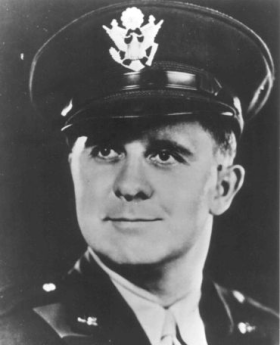
Yet, First Lieutenant Clark Vandersoll Poling of Ohio did not heed his fathers’ wise words. On June 10, 1942, just shy of his 32nd birthday, he joined the U.S. Army’s 131st Quartermaster Truck Regiment as their Chaplain representing the Reformed Church in America.
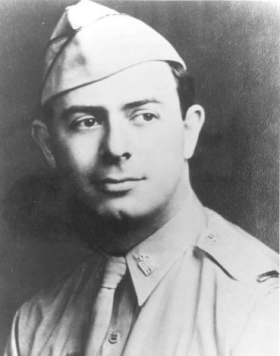
Alexander D. Goode (PhD), born in New York, also followed in his father footsteps when he became a Rabbi. At first, rejected as Chaplain by the Navy in early 1941, he was accepted by the Army after the Japanese attacked the U.S. on December 7th. On July 21, 1942, First Lieutenant Goode was assigned as Chaplain to serve with 333rd Fighter Squadron.
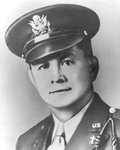
At age 17, George Lansing Fox lied about his age, left Lewiston, Pennsylvania ending up a medical corps assistant on the Western Front During WWI. His bravery would lead to being honored with the Silver Star, Purple Heart and the French Croix de Guerre.
Upon his return, George completed high school, then university, before entering the Boston University School of Theology. He was ordained a Methodist minister in 1934. After the attack on Pearl Harbor, Fox volunteered and was accepted by the Army in July of 1942. On the same day his son, Wyatt, enlisted in the Marine Corps, August 8th of that year, George reported to active duty and would be assigned Chaplain for the 411th Coast Artillery Battalion.
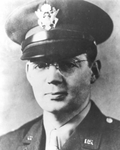
Father John Patrick Washington of New Jersey began his Catholic priesthood in 1935. Athletic, intelligent, he sought to do more for his country and entered active duty May 9, 1942. Named the chief of the Chaplains’ Reserve Pool, in Ft. Benjamin Harrison, Indiana, he was attached to the 76th Infantry Division.
Essential training
As fate would have it, these four men of varying faiths, all studied together at the Army Chaplains School at Harvard University. The training lasted five weeks before they were shipped back to their company. During their time spent at Cambridge the Chaplains courses covered: map recognition, first aide, including finding soldiers with simulated wounds and treating them, grave registration and reports, writing letters of condolence, calisthenics, gas mask drills, and military law.
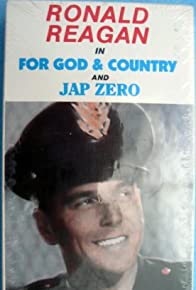
The position of Chaplain was so important that a 43-minute film starring Ronald Reagan as a Chaplain was produced in Hollywood in 1943. For God and Country combines a rich cast to depict this selfless and critical component of “sky pilots” who would give solace and encouragement to the U.S. military units fighting
Getting to the Front
In 1942, The SS Dorchester, a passenger steamship, was requisitioned by the US War Shipping Administration for the use of transporting Army troops. This ship held over 900 men traveling to their fate in Europe through dangerous waters known to be scattered with German submarine wolf packs.
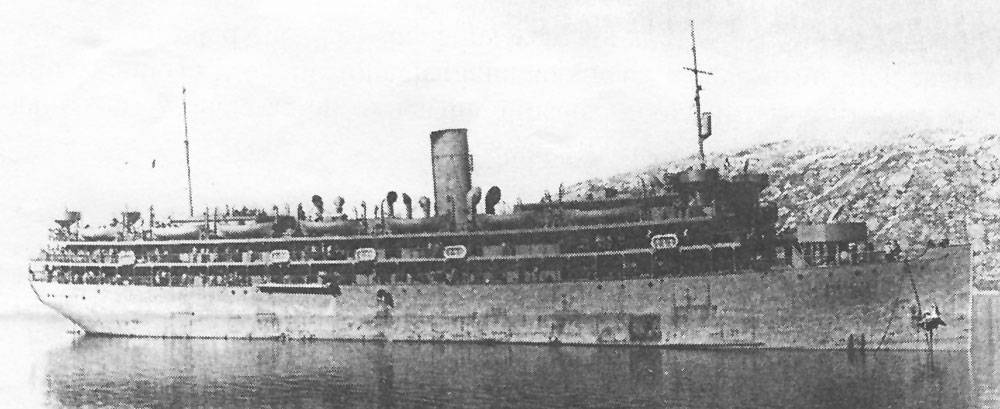
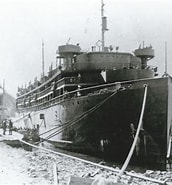
In January of 1943, the Four Chaplains met again in New York City. They were to board the SS Dorchester and, along with five other ships, were to head to Army Command Base at Narsarsuaq in southern Greenland.
In the early morning of February 3, 1943, at 12:55 a.m., the German submarine 223 torpedoed the bow of the Dorchester. The impact caused an immediate loss of steam, which in turn hindered the signal, six blast of the whistle, to abandon ship. Communication was destroyed and, at first, no flares could be deployed. The list to the port side prevented the lowering of some of the lifeboats.
In the 27 minutes before the Dorchester sank in the frigid waters, the Four Chaplains helped those trapped below calmly reach the deck and into life preservers.
Two of the accompanying U.S. Coast Guard cutters, the Escanaba, and the Comanche, hurried to rescue those who had donned life vests. However, men became so stiff in the icy waters they could not grasp the cargo nets to be rescued. Members of the Escanaba employed a new “retriever” technique where men in wet suits swam to the soldiers, tied a rope around them, pulling them to safety.

Just before the ship slipped to its watery grave, it became apparent there were not enough life vests for all the 902 aboard.
The Four Chaplains, without hesitation, gave up their own life preservers to four young men. Witnesses described the Four Chaplains, standing arm in arm at the railing, singing hymns and praying as they went down with the ship.
As I swam away from the ship, I looked back. The flares had lighted everything. The bow came up high and she slid under. The last thing I saw, the Four Chaplains were up there praying for the safety of the men. They had done everything they could. I did not see them again. They themselves did not have a chance without their life jackets.
— Grady Clark, survivor
Of the 902 men on the SS Dorchester only 230 survived in what was to become the worst single loss of any American personnel of any U.S. convoy during WWII.
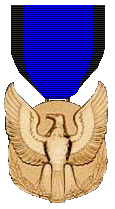
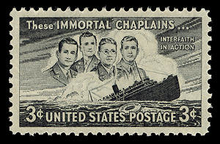
While the Four Chaplains posthumously received the Distinguished Service Cross and Purple Heart, they did not qualify for the Medal of Honor as they had not served in combat. However, Congress, moved by the Four Chaplains courage, created a specific medal for them with the same weight and honor. They were also honored in 1948 with a commemorative postage stamp.
Although First Lieutenant Poling did not heed his father’s words, it is impossible to know how many lives he and the other three men of the cloth helped save that dark early morning as they guided and prayed for those fighting for their lives.
The Immortal Chaplains, who gave four young men the gift of life, should be celebrated not only on February 3, but everyday as examples of unselfish sacrifice and bravery defending our country.
